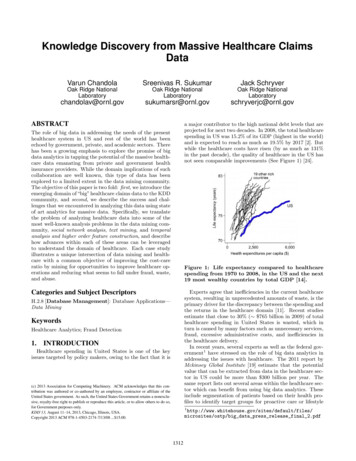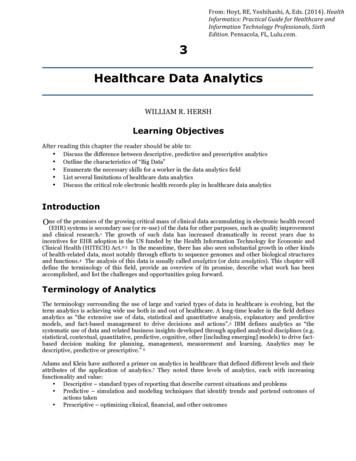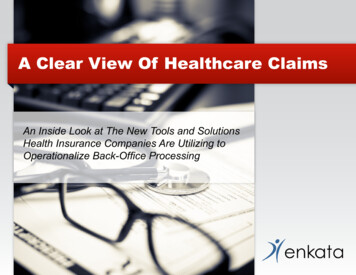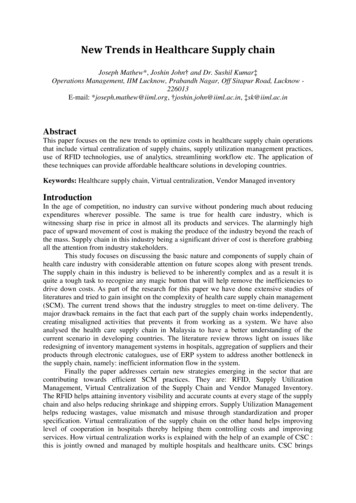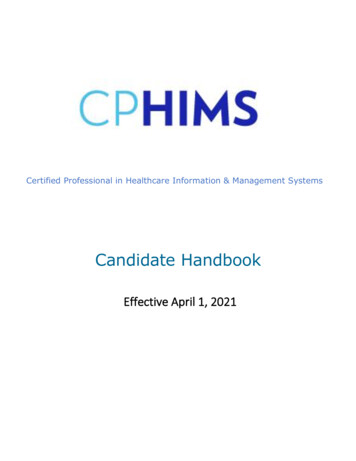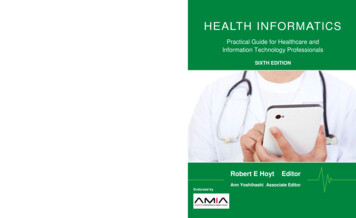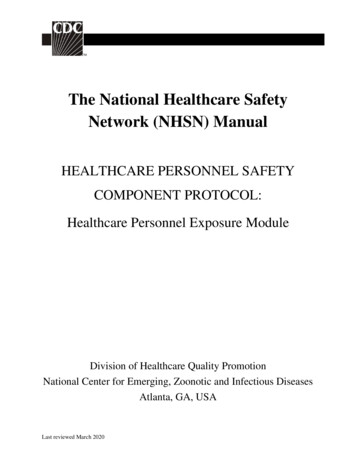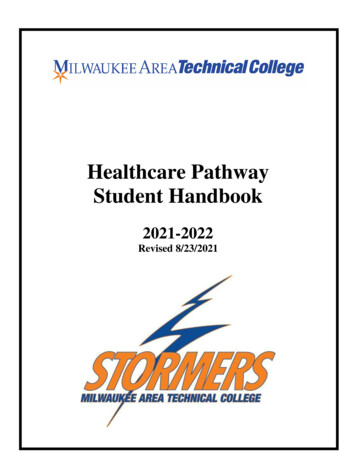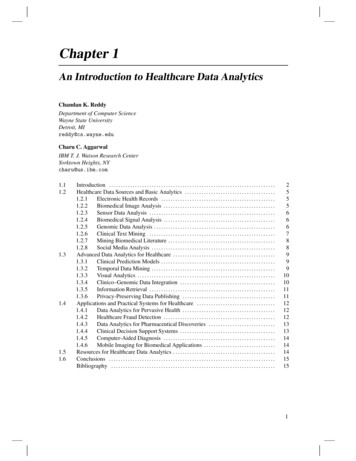
Transcription
Chapter 1An Introduction to Healthcare Data AnalyticsChandan K. ReddyDepartment of Computer ScienceWayne State UniversityDetroit, MIreddy@cs.wayne.eduCharu C. AggarwalIBM T. J. Watson Research CenterYorktown Heights, NYcharu@us.ibm.com1.11.21.31.41.51.6Introduction . . . . . . . . . . . . . . . . . . . . . . . . . . . . . . . . . . . . . . . . . . . . . . . . . . . . . . . . . . . . . . . . . . . . . .Healthcare Data Sources and Basic Analytics . . . . . . . . . . . . . . . . . . . . . . . . . . . . . . . . . . . . . .1.2.1Electronic Health Records . . . . . . . . . . . . . . . . . . . . . . . . . . . . . . . . . . . . . . . . . . . . . . . .1.2.2Biomedical Image Analysis . . . . . . . . . . . . . . . . . . . . . . . . . . . . . . . . . . . . . . . . . . . . . . .1.2.3Sensor Data Analysis . . . . . . . . . . . . . . . . . . . . . . . . . . . . . . . . . . . . . . . . . . . . . . . . . . . . .1.2.4Biomedical Signal Analysis . . . . . . . . . . . . . . . . . . . . . . . . . . . . . . . . . . . . . . . . . . . . . . .1.2.5Genomic Data Analysis . . . . . . . . . . . . . . . . . . . . . . . . . . . . . . . . . . . . . . . . . . . . . . . . . . .1.2.6Clinical Text Mining . . . . . . . . . . . . . . . . . . . . . . . . . . . . . . . . . . . . . . . . . . . . . . . . . . . . .1.2.7Mining Biomedical Literature . . . . . . . . . . . . . . . . . . . . . . . . . . . . . . . . . . . . . . . . . . . . .1.2.8Social Media Analysis . . . . . . . . . . . . . . . . . . . . . . . . . . . . . . . . . . . . . . . . . . . . . . . . . . . .Advanced Data Analytics for Healthcare . . . . . . . . . . . . . . . . . . . . . . . . . . . . . . . . . . . . . . . . . . .1.3.1Clinical Prediction Models . . . . . . . . . . . . . . . . . . . . . . . . . . . . . . . . . . . . . . . . . . . . . . . .1.3.2Temporal Data Mining . . . . . . . . . . . . . . . . . . . . . . . . . . . . . . . . . . . . . . . . . . . . . . . . . . . .1.3.3Visual Analytics . . . . . . . . . . . . . . . . . . . . . . . . . . . . . . . . . . . . . . . . . . . . . . . . . . . . . . . . . .1.3.4Clinico–Genomic Data Integration . . . . . . . . . . . . . . . . . . . . . . . . . . . . . . . . . . . . . . . .1.3.5Information Retrieval . . . . . . . . . . . . . . . . . . . . . . . . . . . . . . . . . . . . . . . . . . . . . . . . . . . . .1.3.6Privacy-Preserving Data Publishing . . . . . . . . . . . . . . . . . . . . . . . . . . . . . . . . . . . . . . .Applications and Practical Systems for Healthcare . . . . . . . . . . . . . . . . . . . . . . . . . . . . . . . . .1.4.1Data Analytics for Pervasive Health . . . . . . . . . . . . . . . . . . . . . . . . . . . . . . . . . . . . . . .1.4.2Healthcare Fraud Detection . . . . . . . . . . . . . . . . . . . . . . . . . . . . . . . . . . . . . . . . . . . . . . .1.4.3Data Analytics for Pharmaceutical Discoveries . . . . . . . . . . . . . . . . . . . . . . . . . . . .1.4.4Clinical Decision Support Systems . . . . . . . . . . . . . . . . . . . . . . . . . . . . . . . . . . . . . . . .1.4.5Computer-Aided Diagnosis . . . . . . . . . . . . . . . . . . . . . . . . . . . . . . . . . . . . . . . . . . . . . . .1.4.6Mobile Imaging for Biomedical Applications . . . . . . . . . . . . . . . . . . . . . . . . . . . . . .Resources for Healthcare Data Analytics . . . . . . . . . . . . . . . . . . . . . . . . . . . . . . . . . . . . . . . . . . .Conclusions . . . . . . . . . . . . . . . . . . . . . . . . . . . . . . . . . . . . . . . . . . . . . . . . . . . . . . . . . . . . . . . . . . . . . .Bibliography . . . . . . . . . . . . . . . . . . . . . . . . . . . . . . . . . . . . . . . . . . . . . . . . . . . . . . . . . . . . . . . . . . . . .255566678899910101111121212131314141415151
2Healthcare Data Analytics1.1 IntroductionWhile the healthcare costs have been constantly rising, the quality of care provided to the patients in the United States have not seen considerable improvements. Recently, several researchershave conducted studies which showed that by incorporating the current healthcare technologies, theyare able to reduce mortality rates, healthcare costs, and medical complications at various hospitals.In 2009, the US government enacted the Health Information Technology for Economic and ClinicalHealth Act (HITECH) that includes an incentive program (around 27 billion) for the adoption andmeaningful use of Electronic Health Records (EHRs).The recent advances in information technology have led to an increasing ease in the ability tocollect various forms of healthcare data. In this digital world, data becomes an integral part of healthcare. A recent report on Big Data suggests that the overall potential of healthcare data will be around 300 billion [12]. Due to the rapid advancements in the data sensing and acquisition technologies,hospitals and healthcare institutions have started collecting vast amounts of healthcare data abouttheir patients. Effectively understanding and building knowledge from healthcare data requires developing advanced analytical techniques that can effectively transform data into meaningful andactionable information. General computing technologies have started revolutionizing the manner inwhich medical care is available to the patients. Data analytics, in particular, forms a critical component of these computing technologies. The analytical solutions when applied to healthcare datahave an immense potential to transform healthcare delivery from being reactive to more proactive.The impact of analytics in the healthcare domain is only going to grow more in the next severalyears. Typically, analyzing health data will allow us to understand the patterns that are hidden inthe data. Also, it will help the clinicians to build an individualized patient profile and can accuratelycompute the likelihood of an individual patient to suffer from a medical complication in the nearfuture.Healthcare data is particularly rich and it is derived from a wide variety of sources such assensors, images, text in the form of biomedical literature/clinical notes, and traditional electronicrecords. This heterogeneity in the data collection and representation process leads to numerouschallenges in both the processing and analysis of the underlying data. There is a wide diversity in thetechniques that are required to analyze these different forms of data. In addition, the heterogeneityof the data naturally creates various data integration and data analysis challenges. In many cases,insights can be obtained from diverse data types, which are otherwise not possible from a singlesource of the data. It is only recently that the vast potential of such integrated data analysis methodsis being realized.From a researcher and practitioner perspective, a major challenge in healthcare is its interdisciplinary nature. The field of healthcare has often seen advances coming from diverse disciplines suchas databases, data mining, information retrieval, medical researchers, and healthcare practitioners.While this interdisciplinary nature adds to the richness of the field, it also adds to the challenges inmaking significant advances. Computer scientists are usually not trained in domain-specific medicalconcepts, whereas medical practitioners and researchers also have limited exposure to the mathematical and statistical background required in the data analytics area. This has added to the difficultyin creating a coherent body of work in this field even though it is evident that much of the availabledata can benefit from such advanced analysis techniques. The result of such a diversity has often ledto independent lines of work from completely different perspectives. Researchers in the field of dataanalytics are particularly susceptible to becoming isolated from real domain-specific problems, andmay often propose problem formulations with excellent technique but with no practical use. Thisbook is an attempt to bring together these diverse communities by carefully and comprehensivelydiscussing the most relevant contributions from each domain. It is only by bringing together thesediverse communities that the vast potential of data analysis methods can be harnessed.
An Introduction to Healthcare Data AnalyticsChapter 2:Electronic Health RecordsChapter 9:Social MediaChapter 3: ImagesChapter 4: SensorsData Sources& BasicChapter 8:Biomedical LiteratureChapter 7:Clinical NotesChapter 5: SignalsChapter 6: GenomicChapter 10:Chapter 11:Temporal Data MiningChapter 15:Data PrivacyAdvancedChapter 12:Chapter 14:Chapter 13:Chapter 16:Pervasive HealthChapter 17:Chapter 21:SystemsChapter 18:Drug DiscoveryChapter 20:CAD SystemsChapter 19:Decision SupportFIGURE 1.1: The overall organization of the book’s contents.3
4Healthcare Data AnalyticsAnother major challenge that exists in the healthcare domain is the “data privacy gap” betweenmedical researchers and computer scientists. Healthcare data is obviously very sensitive because itcan reveal compromising information about individuals. Several laws in various countries, such asthe Health Insurance Portability and Accountability Act (HIPAA) in the United States, explicitlyforbid the release of medical information about individuals for any purpose, unless safeguards areused to preserve privacy. Medical researchers have natural access to healthcare data because theirresearch is often paired with an actual medical practice. Furthermore, various mechanisms exist inthe medical domain to conduct research studies with voluntary participants. Such data collection isalmost always paired with anonymity and confidentiality agreements.On the other hand, acquiring data is not quite as simple for computer scientists without a propercollaboration with a medical practitioner. Even then, there are barriers in the acquisition of data.Clearly, many of these challenges can be avoided if accepted protocols, privacy technologies, andsafeguards are in place. Therefore, this book will also address these issues. Figure 1.1 provides anoverview of the organization of the book’s contents. This book is organized into three parts:1. Healthcare Data Sources and Basic Analytics: This part discusses the details of varioushealthcare data sources and the basic analytical methods that are widely used in the processing and analysis of such data. The various forms of patient data that is currently beingcollected in both clinical and non-clinical environments will be studied. The clinical data willhave the structured electronic health records and biomedical images. Sensor data has beenreceiving a lot attention recently. Techniques for mining sensor data and biomedical signalanalysis will be presented. Personalized medicine has gained a lot of importance due to theadvancements in genomic data. Genomic data analysis involves several statistical techniques.These will also be elaborated. Patients’ in-hospital clinical data will also include a lot of unstructured data in the form of clinical notes. In addition, the domain knowledge that can beextracted by mining the biomedical literature, will also be discussed. The fundamental datamining, machine learning, information retrieval, and natural language processing techniquesfor processing these data types will be extensively discussed. Finally, behavioral data capturedthrough social media will also be discussed.2. Advanced Data Analytics for Healthcare: This part deals with the advanced analytical methods focused on healthcare. This includes the clinical prediction models, temporal data miningmethods, and visual analytics. Integrating heterogeneous data such as clinical and genomicdata is essential for improving the predictive power of the data that will also be discussed.Information retrieval techniques that can enhance the quality of biomedical search will bepresented. Data privacy is an extremely important concern in healthcare. Privacy-preservingdata publishing techniques will therefore be presented.3. Applications and Practical Systems for Healthcare: This part focuses on the practical applications of data analytics and the systems developed using data analytics for healthcareand clinical practice. Examples include applications of data analytics to pervasive healthcare,fraud detection, and drug discovery. In terms of the practical systems, we will discuss the details about the clinical decision support systems, computer assisted medical imaging systems,and mobile imaging systems.These different aspects of healthcare are related to one another. Therefore, the chapters in eachof the aforementioned topics are interconnected. Where necessary, pointers are provided acrossdifferent chapters, depending on the underlying relevance. This chapter is organized as follows.Section 1.2 discusses the main data sources that are commonly used and the basic techniques forprocessing them. Section 1.3 discusses advanced techniques in the field of healthcare data analytics.Section 1.4 discusses a number of applications of healthcare analysis techniques. An overview ofresources in the field of healthcare data analytics is presented in Section 1.5. Section 1.6 presentsthe conclusions.
An Introduction to Healthcare Data Analytics51.2 Healthcare Data Sources and Basic AnalyticsIn this section, the various data sources and their impact on analytical algorithms will be discussed. The heterogeneity of the sources for medical data mining is rather broad, and this createsthe need for a wide variety of techniques drawn from different domains of data analytics.1.2.1 Electronic Health RecordsElectronic health records (EHRs) contain a digitized version of a patient’s medical history. Itencompasses a full range of data relevant to a patient’s care such as demographics, problems, medications, physician’s observations, vital signs, medical history, laboratory data, radiology reports,progress notes, and billing data. Many EHRs go beyond a patient’s medical or treatment history andmay contain additional broader perspectives of a patient’s care. An important property of EHRs isthat they provide an effective and efficient way for healthcare providers and organizations to sharewith one another. In this context, EHRs are inherently designed to be in real time and they can instantly be accessed and edited by authorized users. This can be very useful in practical settings. Forexample, a hospital or specialist may wish to access the medical records of the primary provider. Anelectronic health record streamlines the workflow by allowing direct access to the updated records inreal time [30]. It can generate a complete record of a patient’s clinical encounter, and support othercare-related activities such as evidence-based decision support, quality management, and outcomesreporting. The storage and retrieval of health-related data is more efficient using EHRs. It helpsto improve quality and convenience of patient care, increase patient participation in the healthcareprocess, improve accuracy of diagnoses and health outcomes, and improve care coordination [29].Various components of EHRs along with the advantages, barriers, and challenges of using EHRsare discussed in Chapter 2.1.2.2 Biomedical Image AnalysisMedical imaging plays an important role in modern-day healthcare due to its immense capabilityin providing high-quality images of anatomical structures in human beings. Effectively analyzingsuch images can be useful for clinicians and medical researchers since it can aid disease monitoring,treatment planning, and prognosis [31]. The most popular imaging modalities used to acquire abiomedical image are magnetic resonance imaging (MRI), computed tomography (CT), positronemission tomography (PET), and ultrasound (U/S). Being able to look inside of the body withouthurting the patient and being able to view the human organs has tremendous implications on humanhealth. Such capabilities allow the physicians to better understand the cause of an illness or otheradverse conditions without cutting open the patient.However, merely viewing such organs with the help of images is just the first step of the process. The final goal of biomedical image analysis is to be able to generate quantitative informationand make inferences from the images that can provide far more insights into a medical condition.Such analysis has major societal significance since it is the key to understanding biological systemsand solving health problems. However, it includes many challenges since the images are varied,complex, and can contain irregular shapes with noisy values. A number of general categories ofresearch problems that arise in analyzing images are object detection, image segmentation, imageregistration, and feature extraction. All these challenges when resolved will enable the generationof meaningful analytic measurements that can serve as inputs to other areas of healthcare data analytics. Chapter 3 discusses a broad overview of the main medical imaging modalities along with awide range of image analysis approaches.
6Healthcare Data Analytics1.2.3 Sensor Data AnalysisSensor data [2] is ubiquitous in the medical domain both for real time and for retrospectiveanalysis. Several forms of medical data collection instruments such as electrocardiogram (ECG),and electroencaphalogram (EEG) are essentially sensors that collect signals from various parts of thehuman body [32]. These collected data instruments are sometimes used for retrospective analysis,but more often for real-time analysis. Perhaps, the most important use-case of real-time analysisis in the context of intensive care units (ICUs) and real-time remote monitoring of patients withspecific medical conditions. In all these cases, the volume of the data to the processed can be ratherlarge. For example, in an ICU, it is not uncommon for the sensor to receive input from hundreds ofdata sources, and alarms need to be triggered in real time. Such applications necessitate the use ofbig-data frameworks and specialized hardware platforms. In remote-monitoring applications, boththe real-time events and a long-term analysis of various trends and treatment alternatives is of greatinterest.While rapid growth in sensor data offers significant promise to impact healthcare, it also introduces a data overload challenge. Hence, it becomes extremely important to develop novel data analytical tools that can process such large volumes of collected data into meaningful and interpretableknowledge. Such analytical methods will not only allow for better observing patients’ physiologicalsignals and help provide situational awareness to the bedside, but also provide better insights intothe inefficiencies in the healthcare system that may be the root cause of surging costs. The researchchallenges associated with the mining of sensor data in healthcare settings and the sensor miningapplications and systems in both clinical and non-clinical settings is discussed in Chapter 4.1.2.4 Biomedical Signal AnalysisBiomedical Signal Analysis consists of measuring signals from biological sources, the originof which lies in various physiological processes. Examples of such signals include the electroneurogram (ENG), electromyogram (EMG), electrocardiogram (ECG), electroencephalogram (EEG),electrogastrogram (EGG), phonocardiogram (PCG), and so on. The analysis of these signals is vitalin diagnosing the pathological conditions and in deciding an appropriate care pathway. The measurement of physiological signals gives some form of quantitative or relative assessment of the stateof the human body. These signals are acquired from various kinds of sensors and transducers eitherinvasively or non-invasively.These signals can be either discrete or continuous depending on the kind of care or severityof a particular pathological condition. The processing and interpretation of physiological signals ischallenging due to the low signal-to-noise ratio (SNR) and the interdependency of the physiologicalsystems. The signal data obtained from the corresponding medical instruments can be copiouslynoisy, and may sometimes require a significant amount of preprocessing. Several signal processingalgorithms have been developed that have significantly enhanced the understanding of the physiological processes. A wide variety of methods are used for filtering, noise removal, and compactmethods [36]. More sophisticated analysis methods including dimensionality reduction techniquessuch as Principal Component Analysis (PCA), Singular Value Decomposition (SVD), and wavelettransformation have also been widely investigated in the literature. A broader overview of many ofthese techniques may also be found in [1, 2]. Time-series analysis methods are discussed in [37, 40].Chapter 5 presents an overview of various signal processing techniques used for processing biomedical signals.1.2.5 Genomic Data AnalysisA significant number of diseases are genetic in nature, but the nature of the causality betweenthe genetic markers and the diseases has not been fully established. For example, diabetes is well
An Introduction to Healthcare Data Analytics7known to be a genetic disease; however, the full set of genetic markers that make an individualprone to diabetes are unknown. In some other cases, such as the blindness caused by Stargardtdisease, the relevant genes are known but all the possible mutations have not been exhaustivelyisolated. Clearly, a broader understanding of the relationships between various genetic markers,mutations, and disease conditions has significant potential in assisting the development of variousgene therapies to cure these conditions. One will be mostly interested in understanding what kindof health-related questions can be addressed through in-silico analysis of the genomic data throughtypical data-driven studies. Moreover, translating genetic discoveries into personalized medicinepractice is a highly non-trivial task with a lot of unresolved challenges. For example, the genomiclandscapes in complex diseases such as cancers are overwhelmingly complicated, revealing a highorder of heterogeneity among different individuals. Solving these issues will be fitting a major pieceof the puzzle and it will bring the concept of personalized medicine much more closer to reality.Recent advancements made in the biotechnologies have led to the rapid generation of largevolumes of biological and medical information and advanced genomic research. This has also ledto unprecedented opportunities and hopes for genome scale study of challenging problems in lifescience. For example, advances in genomic technology made it possible to study the complete genomic landscape of healthy individuals for complex diseases [16]. Many of these research directionshave already shown promising results in terms of generating new insights into the biology of human disease and to predict the personalized response of the individual to a particular treatment.Also, genetic data are often modeled either as sequences or as networks. Therefore, the work inthis field requires a good understanding of sequence and network mining techniques. Various dataanalytics-based solutions are being developed for tackling key research problems in medicine suchas identification of disease biomarkers and therapeutic targets and prediction of clinical outcome.More details about the fundamental computational algorithms and bioinformatics tools for genomicdata analysis along with genomic data resources are discussed in Chapter 6.1.2.6 Clinical Text MiningMost of the information about patients is encoded in the form of clinical notes. These notesare typically stored in an unstructured data format and is the backbone of much of healthcare data.These contain the clinical information from the transcription of dictations, direct entry by providers,or use of speech recognition applications. These are perhaps the richest source of unexploited information. It is needless to say that the manual encoding of this free-text form on a broad range ofclinical information is too costly and time consuming, though it is limited to primary and secondarydiagnoses, and procedures for billing purposes. Such notes are notoriously challenging to analyzeautomatically due to the complexity involved in converting clinical text that is available in free-textto a structured format. It becomes hard mainly because of their unstructured nature, heterogeneity,diverse formats, and varying context across different patients and practitioners.Natural language processing (NLP) and entity extraction play an important part in inferringuseful knowledge from large volumes of clinical text to automatically encoding clinical informationin a timely manner [22]. In general, data preprocessing methods are more important in these contextsas compared to the actual mining techniques. The processing of clinical text using NLP methods ismore challenging when compared to the processing of other texts due to the ungrammatical natureof short and telegraphic phrases, dictations, shorthand lexicons such as abbreviations and acronyms,and often misspelled clinical terms. All these problems will have a direct impact on the variousstandard NLP tasks such as shallow or full parsing, sentence segmentation, text categorization, etc.,thus making the clinical text processing highly challenging. A wide range of NLP methods and datamining techniques for extracting information from the clinical text are discussed in Chapter 7.
8Healthcare Data Analytics1.2.7 Mining Biomedical LiteratureA significant number of applications rely on evidence from the biomedical literature. The latteris copious and has grown significantly over time. The use of text mining methods for the long-termpreservation, accessibility, and usability of digitally available resources is important in biomedicalapplications relying on evidence from scientific literature. Text mining methods and tools offer novelways of applying new knowledge discovery methods in the biomedical field [21][20]. Such toolsoffer efficient ways to search, extract, combine, analyze and summarize textual data, thus supportingresearchers in knowledge discovery and generation. One of the major challenges in biomedical textmining is the multidisciplinary nature of the field. For example, biologists describe chemical compounds using brand names, while chemists often use less ambiguous IUPAC-compliant names orunambiguous descriptors such as International Chemical Identifiers. While the latter can be handledwith cheminformatics tools, text mining techniques are required to extract less precisely definedentities and their relations from the literature. In this context, entity and event extraction methodsplay a key role in discovering useful knowledge from unstructured databases. Because the costof curating such databases is too high, text mining methods offer new opportunities for their effective population, update, and integration. Text mining brings about other benefits to biomedicalresearch by linking textual evidence to biomedical pathways, reducing the cost of expert knowledgevalidation, and generating hypotheses. The approach provides a general methodology to discoverpreviously unknown links and enhance the way in which biomedical knowledge is organized. Moredetails about the challenges and algorithms for biomedical text mining are discussed in Chapter 8.1.2.8 Social Media AnalysisThe rapid emergence of various social media resources such as social networking sites,blogs/microblogs, forums, question answering services, and online communities provides a wealthof information about public opinion on various aspects of healthcare. Social media data can bemined for patterns and knowledge that can be leveraged to make useful inferences about population health and public health monitoring. A significant amount of public health information canbe gleaned from the inputs of various participants at social media sites. Although most individual social media posts and messages contain little informational value, aggregation of millions ofsuch messages can generate important knowledge [4, 19]. Effectively analyzing these vast pieces ofknowledge can significantly reduce the latency in collecting such complex information.Previous research on social media analytics for healthcare has focused on capturing aggregatehealth trends such as outbreaks of infectious diseases, detecting reports of adverse drug interactions,and improving interventional capabilities for health-related activities. Disease outbreak detection isoften strongly reflected in the content of social media and an analysis of the history of the contentprovides valuable insights about disease outbreaks. Topic models are frequently used for high-levelanalysis of such health-related content. An additional source of information in social media sitesis obtained from online doctor and patient communities. Since medical conditions recur acrossdifferent individuals, the online communities provide a valuable source of knowledge about variousmedical conditions. A major challenge in social media analysis is that the data is often unreliable,and therefore the results must be interpreted with caution. More discussion about the impact ofsocial media analytics in improving healthcare is given in Chapter 9.
An Introduction to Healthcare Data Analytics91.3 Advanced Data Analytics for HealthcareThis section will discuss a number of advanced data analytics methods for healthcare. Thesetechniques include various data mining and machine learning models that need to be adapted to thehealthcare domain.1.3.1 Clinical Prediction ModelsClinical prediction forms a critical component of modern-day healthcare. Several predictionmodels have been extensively investigated and have been successfully deployed in clinical practice[26]. Such models have made a tremendous impact in terms of diagnosis and treatment of diseases.Most successful supervised learning methods that have been employed for clinical prediction tasksfall into three categories: (i) Statistical methods
An Introductionto Healthcare Data Analytics 5 1.2 Healthcare Data Sources and Basic Analytics In this section, the various data sources and their impact on analytical algorithms will be dis-cussed. The heterogeneity of the sources for medical data mining is rather broad, and this creates


